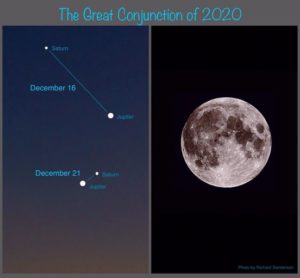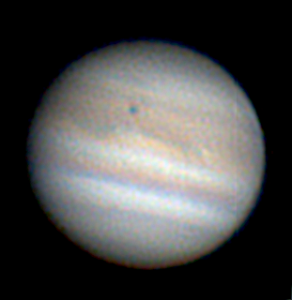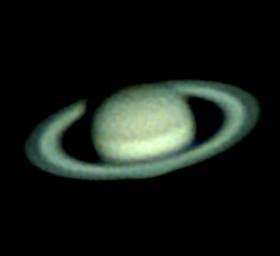What is the Great Conjunction of 2020 and how you can see it.
You may have heard about the “Great Conjunction” or the “Christmas Star” that will be visible on January 21, 2020. Hopefully, this will explain the basics of what this event is and why it is so special.
So here’s what will happen. Jupiter and Saturn will appear very close together in the sky, with their closest apparent approach taking place on the 21st. The event is called a Great Conjunction because the 2 planets involved are the largest ones in our Solar System. Jupiter the largest planet in our Solar System is currently about 550 million miles from Earth. Saturn is about a billion miles away. But because of their orbital periods, they appear to line up in our skies for a Great Conjunction about every 20 years.
This year’s spectacle has the 2 giants coming within 1/10th of a degree apart at their closest approach. To put this into scale, the width of your fist held at arm’s length is about 10 degrees. The width of your pinky at the same distance is about 1 degree. The full Moon measured about ½ a degree across. To imagine what 1/10th of a degree is, it is about the thickness of a dime held at arm’s length. So as you can now visualize, Jupiter and Saturn will be very close together in the sky.
is about 1 degree. The full Moon measured about ½ a degree across. To imagine what 1/10th of a degree is, it is about the thickness of a dime held at arm’s length. So as you can now visualize, Jupiter and Saturn will be very close together in the sky.
So we know that they will appear close together in the sky. But what will it look like? Jupiter is the brightest object currently in the night sky, shining at magnitude -2.0. For comparison, the faintest stars you can see from a dark sky location is about magnitude 6.5, while the Sun shines at magnitude -26.74. Saturn at magnitude 0.6, shines much dimmer than Jupiter, remember it’s smaller and nearly twice as far away from us as Jupiter.
To make things even more notable, the Great Conjunction occurs on the Winter Solstice, the shortest day of the year.
During the days leading up to the conjunction, you watch the pair each night as they get nearer to each other. To see the conjunction, you’re going to need a horizon with a good view (little to no obstacle) to the Southwest. When the sun sets, the pair will be about 20 degrees above the southwestern horizon. On the 21st the pair will set at 6:53pm, so that you will want to start looking 15 minutes or so after sunset as the sky begins darkening. On the evening of December 16th and 17th, the Moon will join the pair in the sky creating a beautiful spectacle.
 While you don’t need any special equipment to see the conjunction, but views through binoculars or a telescope, will show the Galilean Moons of Jupiter and in a telescope, you’ll also see Saturn’s rings. A few days before and after the 21st views in a telescope at low power should show both Jupiter and Saturn in the same field of view.
While you don’t need any special equipment to see the conjunction, but views through binoculars or a telescope, will show the Galilean Moons of Jupiter and in a telescope, you’ll also see Saturn’s rings. A few days before and after the 21st views in a telescope at low power should show both Jupiter and Saturn in the same field of view.
The last time that Jupiter and Saturn have appeared this close in the sky last happened in 1623, but they were awfully close to the Sun and weren’t visible in the glare of the Sun. So, the last time that humans witnessed a Great Conjunction this close, was in the year 1226. The next time we’ll get one similar to this will be on March 15th, 2080.
Can Jupiter actually pass in front of Saturn from out view? Yes, it can, that’s called a Mutual Conjunction and those events are extremely rare, with the last one occurring more than 8 thousand years ago!
What if you can’t get to a place to see this or the skies are cloudy? Fortunately, the internet can save you. Adler Planetarium in Chicago will be live streaming the event beginning at 6pm Eastern. Lowell Observatory in Flagstaff, Arizona will also stream the event beginning at 7pm Eastern.
Wishing you clear skies and hoping that you get to enjoy this truly spectacular event!
Moon photo and graphic courtesy of Richard Sanderson. Jupiter and Saturn images courtesy of Wayne Zuhl
All opinions, information and data provided is deemed reliable but is subject to errors and omissions. Not intended to solicit other Brokers’ clients. We cooperate with them fully.


